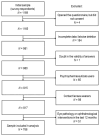The Relationship Between Anxiety Sensitivity, Emotional States, and Dry Eye Disease Symptom Severity: A Cross-Sectional Study
- PMID: 40265404
- PMCID: PMC12015891
- DOI: 10.3390/vision9020036
The Relationship Between Anxiety Sensitivity, Emotional States, and Dry Eye Disease Symptom Severity: A Cross-Sectional Study
Abstract
Dry eye disease (DED) is often comorbid with psychiatric conditions and psychological disturbances like anxiety and depression. The psychological symptoms are mostly considered to be a consequence of DED or a side-effect of medication. However, the possible psychological etiology of DED is seldom explored. This study explores the relationship between anxiety sensitivity (AS), unpleasant emotional states, and the severity of DED symptoms in a healthy general population sample in Croatia. A total of 766 adults (62.27% females) aged between 18 and 88 years completed an online survey consisting of the Ocular Surface Disease Index (OSDI), Anxiety Sensitivity Index (ASI), and Depression Anxiety Stress Scales (DASS21) together with socio-demographic data. The results revealed significant positive correlations between ASI, emotional states, and OSDI (r = 0.25-0.29, p < 0.01). Mediation analysis showed that DASS21 significantly mediates the relationship between ASI and OSDI (B = 0.1, CI = [0.004, 0.2]). Highly anxiety sensitive people are more sensitive to DED symptoms, which additionally increases in a state of emotional stress. Thus, DED symptoms are perceived more intensely and frequently than in less sensitive people. Understanding these associations is crucial for comprehensive DED management, indicating potential benefits from addressing psychological health in DED patients and eye health in psychiatric patients.
Keywords: DED; anxiety; anxiety sensitivity; depression; dry eye disease; ocular surface disease; stress.
Conflict of interest statement
The authors declare no conflicts of interest.
Figures


Similar articles
-
Relationship Between Dry Eye Disease and Emotional Disorder: The Mediating Effect of Health Anxiety.Front Public Health. 2022 Feb 28;10:771554. doi: 10.3389/fpubh.2022.771554. eCollection 2022. Front Public Health. 2022. PMID: 35296049 Free PMC article.
-
The Association Between Dry Eye Disease With Depression, Anxiety and Sleep Disturbance During COVID-19.Front Psychiatry. 2022 Jan 5;12:802302. doi: 10.3389/fpsyt.2021.802302. eCollection 2021. Front Psychiatry. 2022. PMID: 35069294 Free PMC article.
-
Impact of dry eye disease on psychological symptoms among Chinese doctoral students studying abroad.Medicine (Baltimore). 2024 Sep 20;103(38):e39786. doi: 10.1097/MD.0000000000039786. Medicine (Baltimore). 2024. PMID: 39312353 Free PMC article.
-
Dry eye disease and psychiatric disorders: A systematic review and meta-analysis.Eur J Ophthalmol. 2022 Jul;32(4):1872-1889. doi: 10.1177/11206721211060963. Epub 2021 Dec 22. Eur J Ophthalmol. 2022. PMID: 34935549 Free PMC article.
-
Dry Eye Disease: Early Recognition with Guidance on Management and Treatment for Primary Care Family Physicians.Ophthalmol Ther. 2020 Dec;9(4):877-888. doi: 10.1007/s40123-020-00308-z. Epub 2020 Oct 22. Ophthalmol Ther. 2020. PMID: 33090327 Free PMC article. Review.
References
-
- Källmark F. Dry eye disease (DED): A major public health problem. Br. J. Healthc. Manag. 2015;21:456–464. doi: 10.12968/bjhc.2015.21.10.456. - DOI
LinkOut - more resources
Full Text Sources
Research Materials

